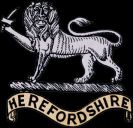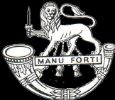
The Herefordshire Rifle Volunteers
1860 - 1880
1st Administrative Battalion
In 1860, in response to a perceived invasion threat the Country wide Rifle Volunteer Corps was formed for home Defence. This saw eight Rifle Volunteer Corps in Herefordshire and three in Radnorshire as the 1st Administrative Battalion, the Herefordshire Rifle Volunteers. Over the next twenty years there were various changes to the location and strengths of the various corps within the Herefordshire Rifle Volunteers.
Lord Bateman and Sir John Benn Walsh Bt, the Lord Lieutenants of Herefordshire and Radnorshire respectively, together with the original officers, were responsible for the success which attended the formation of the Volunteer Rifle Corps in the two counties. Initially these eleven VRCs were entirely independent of one another, but, as a consequence of War Office circulars dated 24 March and 4 September 1860, they became components of 1st Administrative Battalion HRV. Nevertheless, they retained a great measure of individuality and independence.
The object of the formation of an Administrative Battalion was to unite the different corps composing it under one common head, to secure uniformity of drill among them, and to afford the advantage of the instruction and assistance of an adjutant. It was not intended to interfere with the financial arrangements of the separate corps or with the operation of their respective rules, or to compel them to meet together for battalion drill in ordinary times, except with their own consent. Furthermore, an establishment was laid down providing a staff for a rural battalion in accordance with the number of companies or corps administered by it. To warrant a lieutenant-colonel, a major and an adjutant, it was necessary to have at least ten companies, while less than four could not stand alone.
As Herefordshire had eight corps of company strength and Radnorshire had only three, one of which, New Radnor, was only of half company strength, a union between the Volunteer corps of the two counties was of obvious mutual advantage. Furthermore, this merger was fostered by the fact that not only did the border share a common history, but also Presteign, the county town of Radnorshire, fell within the diocese of Hereford. Therefore, by 1863 the Army List showed the RRV as united with 1st Administrative Battalion of the HRV. This connection with Radnorshire continued to 1920, and to an extent was revived with the formation of the Home Guard in 1940.
In view of the historic relationship between the military forces of Hereford and Radnor it is pleasing to note that the history of the Radnorshire Militia was written by Lt-Col. Gilbert Drage DSO, who commanded 1st Battalion the Herefordshire Regiment during the First World War.
On the formation of 1st Administrative Battalion the HRV in 1860, Capt. Robert Fieldon - Hereford City VRC was appointed lieutenant colonel to command the battalion, with Capt Daniel Peploe as the first adjutant. Capt Peploe, late of the Dragoon Guards and afterward known as Peploe Webb, resigned the adjutancy in 1867 and continued in the battalion as junior major, later becoming an MP. In 1865 Capt. Thomas Heywood of Ledbury VRC became the first, and then the only, major in the battalion, and he succeeded Col Fieldon to command in 1874.
For all purposes except that of uniting for battalion drill, the command and financial control of the several corps remained in the hands of the captains.
Following the Royal Commission on the Volunteer Forces of 1862, the force was placed on a proper footing by the Volunteer Act of 1863 (26 & 27 Vict c 65), which superseded all previous Acts, and which provided. Inter alia, for a pemanent staff, a standard of efficiency and a capitation grant for the subsidy of each corps. This statute, together with the Volunteer Forces Regulations of 18 September 1863, caused the Volunteer Forces to be reorganized and to become a valuable auxiliary to the British Army as a means of defence.
In the early days there was no government grant; the expenses had to be borne by public subscription and all ranks found their own uniform. The uniform selected was a medium grey with black facings, set off with scarlet piping and worn with black belts. This continued until 1875, when it was replaced by a scarlet uniform with black facings.
The HRV were typical of the Volunteer Force as it existed in rural areas, where the towns were small and scattered, and the population depended largely on agriculture. The company drills necessary for efficiency were completed by the several corps in their own localities, and the only battalion drills were those that were ordered four or five times a year in the various county towns. Much time was wasted in travelling, and the attendance at battalion drill rarely exceeded 250 officers and men.
After the passing of the Volunteer Act of 1863, through which the War Office laid down a standard of efficiency, the percentage of `efficients' to 'enrolled', with an average enrolled strength of 750, ranged between 70 and 78 per cent, and in 1870 it fell to 67 per cent. Nearly every battalion, but especially country battalions covering large areas, had the same experience, and it is difficult to understand why so many of them held on to the old system of battalion drills instead of adopting camps when they were first authorized in 1861.
The Herefordshire Rifle Volunteers went into camp for the first time in 1871 at Broomy Hill, near Hereford, and thereafter attended camp for a week every summer, except for that of 1888. The early camps were voluntary on the part of the men, except for three battalion drills necessary for efficiency and inspection. At that time there was no government camp allowance dependent on regular attendance. The effect of the change was immediately felt, for the percentage of `efficients' rose in 1871 to 74 per cent and in 1872 to 80 per cent.
In 1875 the percentage rose to 91 per cent, the number enrolled being 723 with 664 efficients, and in 1879 it reached 96 per cent with 911 enrolled. Year by year the attendance at camp for the whole week increased, but the number of those who 'marched in, stayed the whole time, and marched out' never exceeded 450. At the same time the daily attendances throughout the week gradually increased until the number present usually reached between 800 and 850 officers and men.
A magazine was published called The Grasshopper in Camp, and a bound copy of the first twelve issues (1871-4) is contained in the Museum of the Herefordshire Light Infantry. From this publication the nickname 'The Grasshoppers' was derived.
In the early years the battalion attended reviews at Gloucester in 1861, Bristol 1862, Oxford 1863 and Windsor 1868, and each year it sent representatives to the National Rifle Association (NRA) meeting at Wimbledon and/or Bisley, and obtained several badges. In 1864 Sgt Dodd of Ross won Sir John Bennett's forty guinea prize; and in 1868 Pte Packwood won the 'Windmill' 1st prize
The 1st Administrative Battalion was gradually reorganized, the weaker corps becoming defunct and being replaced by more active companies. Thus in 1874 the South Archenfield VRC, 5th HRV, then known as 5 (Goodrich) Company, was disbanded, together with the half company forming the New Radnor VRC, 3rd RRV. In 1875 8th HRV (Oddfellows) was increased to a strength of one-and-a-half companies, making good the loss of the New Radnor Corps, while in 1878 2nd HRV (Ross VRC) was increased in strength to form two companies, later known as B and E, to replace the Goodrich Corps. Meanwhile, in 1875, 2nd RRV (Knighton VRC) had become defunct, and in their place was raised in 1878 a new 10 Company at Rhayader, Radnorshire, by Capt. Stephen W. Williams, who later commanded the battalion during the years 1894 to 1899.
The resultant organization of 1st Administrative Battalion Herefordshire Rifle Volunteers (Hereford & Radnor) was as follows:
| Corps | Name |
|---|---|
| 1st | Hereford (City) |
| 2nd | Ross (increased to form a second company (5) in 1878) |
| 3rd | Ledbury |
| 4th | Bromyard |
| 5th | South Archenfield/Goodrich (disbanded in 1874 and replaced by 2nd Ross in 1878) |
| 6th | Leominster |
| 7th | Kington |
| 8th | Hereford (Oddfellows) (increased to one-and-a-half companies) |
| 9th | Presteign |
| 10th | Knighton (disbanded in 1875, replaced by Rhayader Company in 1878) |
| 11th | New Radnor (disbanded in 1874) |
On 19 April 1870 the various military districts in Great Britain were rearranged, and Herefordshire and Radnorshire became part of the 2nd Western Sub-district, having its headquarters in Bristol, and being part of No 4 Western District, with headquarters at Devonport. The general officer commanding the district was given command of the volunteer units in his district. By the Regulation of the Forces Act of 1871, the Militia, Yeomanry and Volunteers were transferred from the jurisdiction of the Lord Lieutenants of the counties to the War Secretary, and thereafter commissions in the Auxiliary Forces were by grant of the Sovereign direct, instead of through the Lord Lieutenant. Furthermore, the Act made the volunteers subject to the Mutiny Act and Articles of War when assembled with the Militia or Regular Forces. The Auxiliary and Reserve Forces Circular of 21 April 1873 stipulated that the Rifle Volunteers should be attached to the infantry sub-district brigades, as constituted under the Cardwell Reforms introduced in 1872.
Herefordshire then came under 22 Brigade Depot, with headquarters at Worcester. The organization comprised brigade, sub-district and brigade depot, as follows:
- 29th Worcestershire Regiment of Foot
- 36th Herefordshire Regiment of Foot
- (67) Worcester Militia of two battalions
- (110) Hereford Militia
- (39) 1st and 2nd Administrative Battalions Worcestershire RV
- (69) 1st Administrative Battalion Herefordshire RV
- (85) Radnorshire Rifle Volunteers united with 1st Administrative Battalion Herefordshire RV.
In January 1879 the committee on the Volunteer Force recommended, inter alia, that the Rifle Volunteers should form an integral part of the Territorial brigade in each sub-district, and that the force should be consolidated into a smaller number of battalions. Thus on 1 April 1881 the Regulations of 1878 were repealed and from that date the administrative battalions ceased to exist, being replaced by consolidated battalions in which the old corps became companies.
1880-1908
1st Herefordshire Rifle Volunteer Corps
The reforms to both the regular and volunteer elements of the Army, known as the Cardwell Reforms, during the 1870s brought about the first of four name changes in 1880, when the title was altered to The Herefordshire Rifle Volunteer Corps (Hereford & Radnor).
In 1881 the Cardwell Reforms were completed with the formation of Regimental Districts consisting of Regular Battalions, Militia Battalions and Volunteer Battalions.
The Regiment (HRVC) joined the 53rd District and was linked to the King’s Shropshire Light Infantry (KSLI), which was formed at the same time. The Regiment became a Volunteer Battalion of the KSLI but retained its identity. This association with the KSLI, the Light Infantry, and Shropshire was to be an enduring one.
The consolidation of 1st Administrative Battalion HRV was completed by 1 November 1880. The battalion was renamed 1st Herefordshire Rifle Volunteer Corps (HRVC) (Hereford & Radnor). The organization of 1881 was as follows:
| Company | Location Old corps | Old corps |
|---|---|---|
| A | Hereford | 1st HRC |
| B | Ross | 2nd HRV |
| C | Ledbury | 3rd HRC |
| D | Bromyard | 4th HRC |
| E | Ross | 5th HRC |
| F | Leominster | 6th HRC |
| G | Kington | 7th HRC |
| H | Hereford | 8th HRC |
| J | Presteign | 1st RRV |
| K | Rhayder | 2nd RRV |
| E | Company gradually merged with B Company, and a new E Company was formed in 1889 at Weobley |
In the meanwhile, far-reaching reforms were also taking place in the Regular Army. In 1876 Col. Stanley's committee recommended that the connection should be more clearly drawn between the line battalions of a brigade and the Militia battalions of a sub-district. It decided that this would be best effected by their being treated as one regiment, such regiments bearing a Territorial designation — the line battalions being the 1st and 2nd and the Militia the 3rd and 4th of such a Territorial regiment, with the depot being common to all. In February 1881 Sir CH Ellice's committee, on the formation of Territorial regiments as proposed by Col Stanley's committee, made suggestions regarding the affiliation of regiments and their title.
In Herefordshire, Worcestershire and Shropshire the result was as follows: 29th Worcestershire Regiment of Foot and 36th Herefordshire Regiment of Foot to be the Worcester and Hereford Regiment; 43rd Monmouthshire Light Infantry and 53rd Shropshire Regiment of Foot to be the Shropshire Regiment (Light Infantry).
In 1881 Mr Childers, Secretary of State for War, carried the scheme to its logical conclusion by the amalgamation of the linked battalions. This merger was authorized by General Order 41 of April 1881 but, surprisingly, certain changes took place on 1 July 1881, resulting in the following formations:
Regimental district 29, Worcester
Worcestershire Regiment:
- 1st Battalion late 29th Worcestershire Regiment of Foot 2nd Battalion late 36th Herefordshire Regiment of Foot
- 3rd Battalion late Worcester Militia
- 4th Battalion late Worcester Militia
Regimental district 53, Shrewsbury
The King's (Shropshire Light Infantry):
- 1st Battalion late 53rd Shropshire Regiment of Foot
- 2nd Battalion late 85th King's Light Infantry
- 3rd Battalion late Shropshire Militia
- 4th Battalion late Herefordshire Militia
It will be noted that, as from 1 July 1881, the sub-district was replaced by the regimental district, having the same precedence number as the first battalion of the regiment. At this juncture it should be mentioned that, immediately prior to this reorganization, the Herefordshire Militia and the HRV (Hereford & Radnor) had severed connection with 22 Brigade Depot at Worcester to join 25 Brigade Depot at Brecon. Herefordshire now severed its connection with Worcester and Brecon and became part of 53rd Regimental District, with the depot at Copthorne Barracks, Shrewsbury.
Although General Order 41 dealt only with Regular and Militia forces, the Volunteer Force was also affected by the scheme, and the RVCs soon became Volunteer battalions of their Territorial regiment, the affiliation being dealt with by War Office circulars as individual cases arose. The RVC of 53rd Regimental District were as follows:
- 1st Shropshire RVC
- 2nd Shropshire RVC
- 1st Herefordshire RVC (Hereford & Radnor)
The Radnorshire companies of 1st HRVC were placed in a peculiar position, as their county was part of 24th Regimental District, with the depot at Brecon. Nevertheless, they continued their association with Herefordshire.
By the authority of a General Order of 1 December 1887, 1st and 2nd Shropshire RVCs assumed the titles of 1st and 2nd Volunteer Battalions K(SLI) in 1888. The RVC (Hereford & Radnor) did not adopt the title 3rd Volunteer Battalion K(SLI) but was such in everything but name.
In 1889 E Company was reformed by Capt WEA Walker in the old parliamentary borough of Weobley, and this had the effect of keeping ten-and-a-half companies on the establishment.
These changes in organization resulted in greater efficiency and made possible more advanced methods of training. The discontinuance of battalion camps held in the county of Hereford and the substitution of brigade camps at a distance proved most popular, as it provided the Volunteers with an opportunity to travel. This fact, coupled with the increased difficulty of returning home at will, had the result of very greatly increasing the numbers attending the camp for the whole period. Thus, in the years 1890, 1891 and 1892 the numbers attending were 597, 675 and 803 respectively. The numbers enrolled during these years were 908, 912 and 975, with `efficients' at 867, 871 and 927 respectively. This represented 95 per cent efficiency for each year. The battalion joined the Welsh Border Brigade in camp at Towyn in 1890 and at Conway in 1892. In 1891 and 1893 it was attached to 3 Infantry Brigade at Aldershot. The battalion had sent two companies to summer drills at Aldershot in 1882 under Maj Suter, and in 1883 a company under Capt Scobie attended the Easter manoeuvres at Brighton.
The first opportunity for active service came during the Boer War. Two Volunteer Service Companies were formed from the three Volunteer Battalions of the KSLI, to reinforce 2nd Battalion KSLI in South Africa. Each Company, serving for one year each, were allowed a strength of 116 all ranks, which made for stiff competition to join them. The first Company went to South Africa in April 1900, and was involved with 2nd Battalion KSLI on several operations. By the time the second Company went out in 1901, the war had changed with most of the time spent on guard duty in blockhouses and escorting trains. Both Companies performed extremely well. In recognition of this, the Volunteer Battalions were granted permission for the Battle Honour ‘South Africa 1900-1902’ to be borne on their Colours.
It has been noted that the first commanding officer was Col Robert Fieldon. He was succeeded in 1874 by Lt Col. Thomas Heywood, who held command until 1893, being followed in succession by Lt Col TH Purser, Lt Col SW Williams in 1894 and in 1899 by Lt Col Mackay JG Scobie. From 1871 onwards the HRVC took every advantage of the annual eight-day camps. From 1890 to 1902 it was one of the six battalions forming the Welsh Border Brigade; from 1903 to 1906 it was one of the four comprising 30 Field Army Brigade (and as such trained in camp for fifteen days), rejoining in 1907 its old brigade, which had been enamed the North Wales Border Brigade. During those years it attended camps in Aldershot; Towyn and other places in Wales; the emergency camp of 1900 at Fleetwood; camps in the Isle of Man and Salisbury Plain, gaining much praise for its memorable route march in 1906 from Southampton; and at Scarborough, where in 1907 the North Wales Border Brigade was commanded by Lt Col MJG Scobie in the absence of the brigadier.
From 1891 the financial arrangements of the battalion had been completely under the control of the finance committee, the quartermaster, Mr Mason Akerman, acted as secretary to both the finance and the clothing committees. In 1897 a general consolidation of finances took place, which finally relieved the company officers of all financial responsibility, after which time the battalion was completely administered by the commanding officer.
With regard to clothing, the whole battalion was provided with greatcoats and equipment, and the Government allowances were supplemented by funds raised by bazaars held for the purpose. In 1891 the battalion adopted a new clothing scheme whereby articles of uniform were issued regularly throughout the battalion at stated intervals. The effect of this was a uniformity of appearance which did much to improve the smart appearance of the men. In 1891 kerseys were issued, in 1892 helmets, and in 1893 trousers. To this end a fixed sum per head was deducted from the capitation grant and credited to the clothing fund, which was administered by the clothing committee.
In the table of precedence of VRCs the position of the Volunteer battalions of Herefordshire and Shropshire was as follows:
| Date | 1st Volunteer Battalion K(SL1) | 2nd Volunteer Battalion K(SLI) | 1st HRVC |
|---|---|---|---|
| 1898 | 169 | 170 | 199 |
| 1900 | 172 | 173 | 204 |
| 1901 | 173 | 174 | 205 |
| 1901 | 174 | 175 | 206 |
| 1903 | 175 | 176 | 207 |
| 1904 | 176 | 177 | 208 |
| 1904 | 176 | 177 | 207 |
With regard to shooting, the battalion sent representatives every year to the NRA meeting at Wimbledon or Bisley, where they obtained several badge for the Queen's Sixty, the Hundred and the St George's. The following is a brief record of some of the principal prizes gained. Sgt Fowler tied in 1881 for the first prize of the St George's, but lost it to Sgt Heiton by one point when shooting off. In 1883 the battalion team won the Belgium Cup for volley firing, and in 1889 Sgt Corey won first prize in the All Corners Aggregate. Corey also shot in the English Twenty at Glasgow in 1886 for the National Challenge Trophy, and four times won the bronze medal, presented to the county by the NRA.
The proprietors of the Hereford Times presented the battalion with a very fine challenge cup, valued at 40 guineas, for the encouragement of individual, team and class firing. It was to be held for a year by the winning company. No company of less than sixty strong on 31 March was allowed to compete, and the number of men in the teams varied with the strength of the companies, each team consisting of one man for every ten men in the company. Each team fired three competitions, and the team with the best aggregate average score won the cup. Badges for the winning team and prizes in money for the best individual scores were given by the Herefordshire and Radnorshire Rifle Association. As an incentive to class firing, none but first class shots were allowed to compete in the teams.
The outlying companies had small armouries and quarters in addition to ranges. At Leominster the armoury and quarters were in the old borough gaol. At Ross they started off at the old dock in 1889, then moved to Wilton Road in 1896 and to Cantilupe Street in 1897. The headquarters at Hereford were houses acquired in 1890 by Maj Scobie (A Company), Capt Morris (H Company) and brigade surgeon Lt Col Giles (Bearer Company). They were later purchased by the battalion under the Military Lands Act of 1892. The site was a square with a block of buildings on one side containing the orderly room, stores, reading and lecture room, and the armourer sergeant's house. On another side was a strong building used as an armoury and store for the Headquarter Companies, and facing it on the opposite side was a large drill shed, 120 feet by 60 feet, made of corrugated iron in a single span, and erected at the expense of Maj Scobie, Capt Morris and Lt Col Giles. The barrack square was enclosed by a brick wall, with marks painted on it for aiming drill, and the Bearer Company had a special iron building for medical stores.
The Hereford companies drilled either on the barrack square or in the drill shed, but during the long summer evenings they had the permission of the city council to drill on the Castle Green.
By 1893 the battalion was well organized and highly efficient, having a Signal Platoon under Cpl Dolby, supplied by Hereford and Kington companies. A Pioneer Platoon under Sgt Biddle was supplied by the Leominster company, and the battalion band at headquarters in Hereford was supported by a band fund, raised by means of the authorized percentage on the Battalion Capitation Grant. Bandmaster St John Jones was in charge for many years, and his son, Band Sgt Jones, superintended the buglers of the battalion, who formed a bugle band in camp. E (Weobley) and G (Kington) companies, with the Lugwardine Platoon of H Company (Hereford), united in providing the battalion with a drum and fife band, so that on all occasions martial music was readily available.
The efficiency of the battalion was evidenced by the fact that it was one of the 27 out of 223 in the United Kingdom selected to form part of the Field Army, a new departure introduced in 1903. However, prior to that members of the HRVC had experience of warfare while serving in 1st and 2nd Volunteer Service Companies (VSC) KSLI, which joined 2nd Battalion KSLI on active service in South Africa, and won for 1st HRVC the battle honour 'South Africa 1900-1902'. The Herefordshire detachment of 1st VSC was under the command of Lt JF Cutler, serving in 1900 and 1901, while Lt Percy Anthony commanded the second detachment, serving from 1901 to 1902. Other officers of the battalion served in South Africa attached to other regiments, notably Maj JRL Rankin with Rimington's Guides and Capt E Kenworthy with Robert's Horse. There is an account of the war services of the VSC in the South African Campaign (1900-1902) in Section 3.
To a large extent the strength and efficiency of the battalion was due to the NCOs, and a large proportion of them held the District Inspector of Musketry's Certificate. Foremost among these was CSgt William Wigley (1st Corps Hereford), late sergeant in 11th Hussars and a veteran of the Crimean War. He gave the battalion the benefit of his experience for twenty-three years.
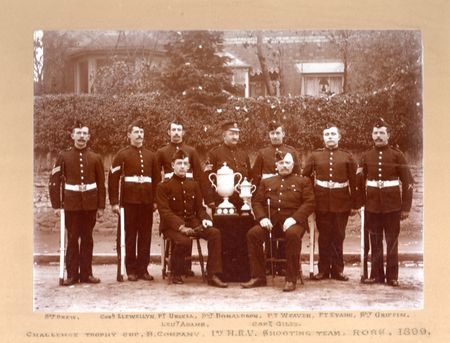
1889
The Brigade Bearer Company
Up to 1889 there were only two-and-a-half companies (A and H) at headquarters, but in that year, when the battalion was detailed as part of the Welsh Border Infantry Brigade, in which Surgeon Maj Peter B Giles of the RVC was appointed brigade surgeon, he specially recruited a third company to act as brigade bearer company. For all practical purposes it was a separate company, but technically it was at first designated part of A Company, as permission had not been obtained to increase the establishment of the battalion to eleven-and-a-half companies.
The Volunteer Medical Staff Corps was first authorized by the Volunteer Regulations of 1887, but how to provide efficient bearer companies for the various brigades was a very difficult problem for each of the brigade surgeons to solve. Surgeon Capt Sleman of the Artist's Rifles stated in an article which appeared in July 1892 that the best solution to the difficulty was made by the Welsh Border Brigade, and subsequently by the East London Brigade, where in each case a bearer company was raised from specially enlisted men. The Welsh Border Brigade Company did not wear the uniform of the Herefordshire RVC but that of the Volunteer Medical Staff Corps, with brown belts. Brigade Surgeon Lt Col PB Giles and the company were therefore the pioneers in the organization of brigade bearer companies, and experience showed the practical advantages of their method over that whereby each battalion I a brigade was required to contribute a certain number of men per rifle company to form a bearer company when in brigade camp. The hospital of the Welsh Border Brigade had the services of men specially trained for the purpose, occupying their own site in the brigade camp, and having their own cooks, who had been taught to supply appropriate foods for the patients. The stretcher-bearers of the various battalions in the brigade drilled together in camp with the bearer company under the command of the brigade surgeon. The Bearer Company became a separate unit and was known as the Welsh Border Bearer Company Royal Army Medical Corps (RAMC), of which a considerable number served in the South African War. On the formation of the Territorial Force in 1908 it became the South Wales Mounted Brigade Field Ambulance RAMC, under the command of Maj JR Raywood, and was part of the South Wales Mounted Brigade in the Western Command.
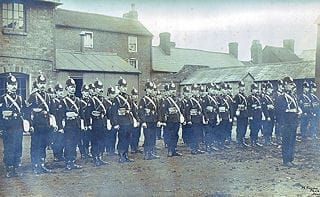
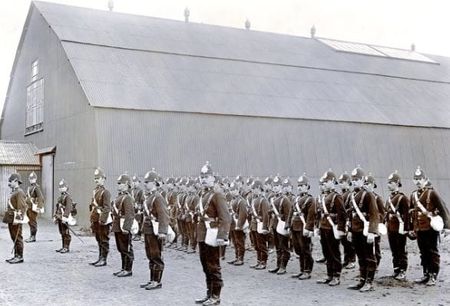
1893
The Cyclist Section
The HRVC, in addition to pioneering the organization of bearer companies, also pioneered the formation of infantry cyclist sections, which were later authorized for the Volunteer Force as a whole in the Volunteer Regulations of 1893, with an establishment of 1 officer, 2 NC0s, 20 privates and 1 bugler. The Cyclist Section of 1st HRVC was formed in 1888 by Maj Scobie. In 1888 it took part in the Cheshire manoeuvres in the neighbourhood of Reading under the same officer. In the autumn of 1889, Maj. Scobie obtained leave from the War Office to form a cyclist camp at Tintern, and this is claimed to have been the first authorized by the War Office. Cyclist Sections from 1st Volunteer Battalion K (SLI), 2nd Volunteer Battalion SWB and 3rd Glamorganshire Volunteer Artillery joined the Herefordshire section, all of which were commanded by Maj Scobie. The Cyclist Section was later commanded by Lt FH Leather.
In this connection may be mentioned a reference in Von Lobe 11's annual Reports (German) on Military Progress (Vol. XXV), an able precis of which by Lt Col E Gunter appeared in the Journal of the United States Institution in 1900. Alluding to the evolution of the military cycle, the writer states that, in England, Lord Wolseley, Col Savile of 26th Middlesex (Cyclists), Col Stracey of the Scots Guards, Maj Scobie of 1st Herefordshire and Lt Eustace Balfour of the London Scottish were the first to take it up.
The record of service of CSgt Griffin of Ross is typical of the Volunteers. He enlisted in 1889, was made LCpl in 1891, joined the Cyclist Section in 1893 and qualified as a sergeant on 24 April 1896. He volunteered for the Service Company, which went out to South Africa to 2nd Battalion KSLI in January 1900, returned in May 1901, and was made Colour Sergeant in 1904. He was still serving when the Volunteers were converted into the Territorial Force.
